by Samantha Kennedy | May 27, 2017
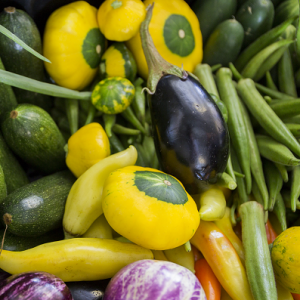 North Florida’s beautiful spring weather means we get to enjoy a variety of delicious, locally-grown fruits and veggies during the summer months. Produce such as bell peppers, squash, tomatoes, greens, corn, cucumbers, okra, peas, eggplant, and a variety of melons are plentiful and fresh from late spring through early fall.
North Florida’s beautiful spring weather means we get to enjoy a variety of delicious, locally-grown fruits and veggies during the summer months. Produce such as bell peppers, squash, tomatoes, greens, corn, cucumbers, okra, peas, eggplant, and a variety of melons are plentiful and fresh from late spring through early fall.
The benefits of eating fresh fruits and vegetables are numerous and well-known. Fruits and veggies provide important vitamins and minerals that are vital to keeping your body working properly. They’re rich in fiber, which is important for digestive health and helps lower cholesterol. They provide antioxidants, which can help reduce your risk of a variety of cancers. They’re low in calories, fat, and sodium, which make them an ideal snack. And their colorful spectrum makes them a beautiful and healthy addition to any meal.
The MyPlate https://www.choosemyplate.gov/MyPlate guidelines call for making half your plate fruits and vegetables as part of a balanced meal. But remember, preparation is key. Steamed, roasted, raw, baked, and grilled veggies will provide the biggest nutritional bang for your buck, allowing the natural flavors to shine through. Deep fried, breaded veggies add unnecessary fat and calories, so be careful not to rely on this cooking method too often.
Mix and match! Pair a leafy green with a starchy vegetable for a wider spectrum of nutrients. Add fruits such as mandarin oranges or dried cranberries to a salad for a little extra sweetness. Try new flavor combinations by adding herbs and spices – but go easy on the salt!
While fresh fruits and vegetables are healthy, delicious, and plentiful during Florida’s summer months, frozen and canned varieties, including juices, can also provide many of the same health benefits. However, be sure to read the label carefully before buying. Look for low sodium or no salt varieties and only purchase 100% juice beverages, as other drinks may contain a lot of artificial flavorings and colors.
For more information about the benefits and uses of fresh North Florida produce, please visit the Panhandle Produce Pointers page at: http://wfrec.ifas.ufl.edu/panhandle-produce-pointers/produce-pointers-sheets/.
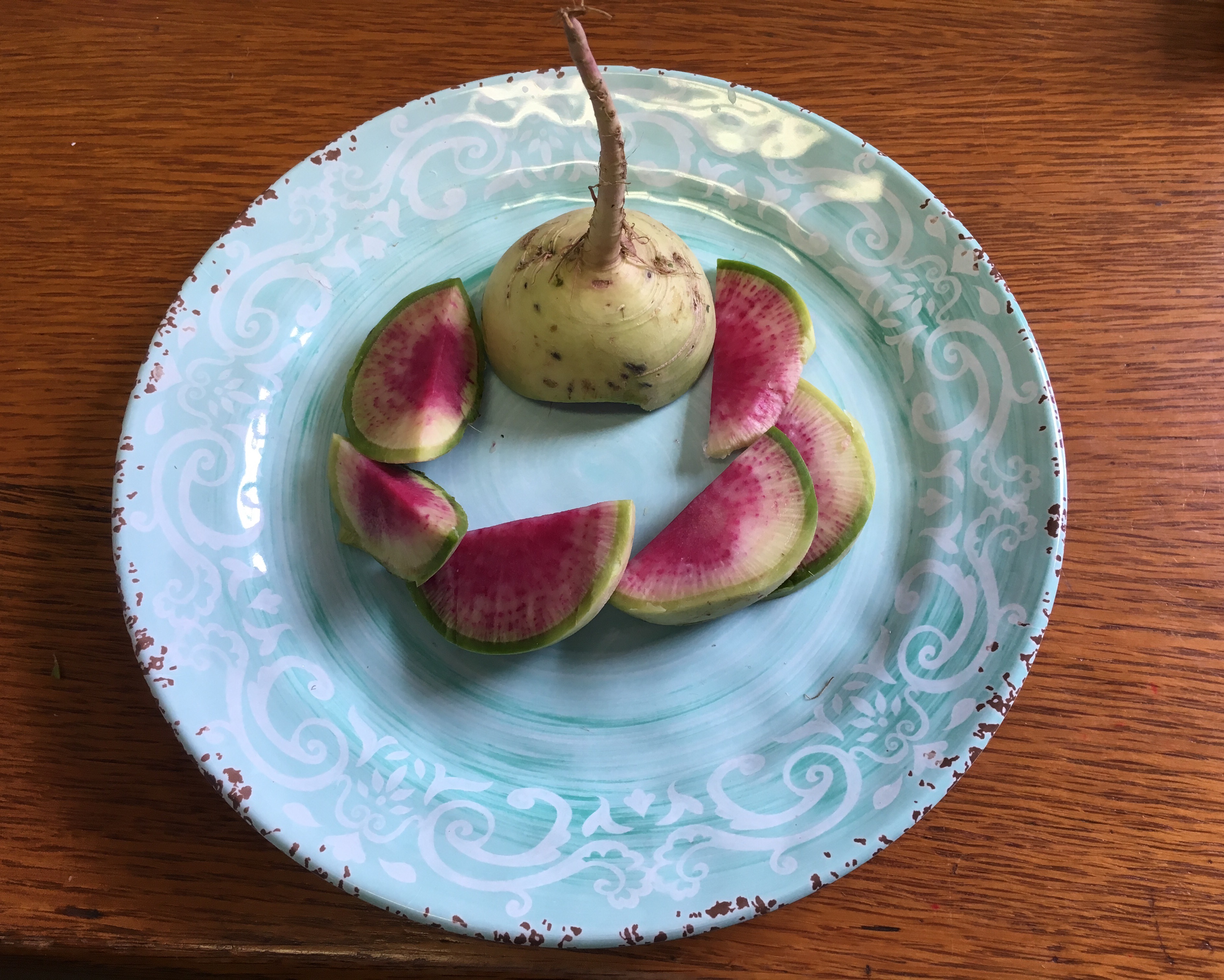
by Laurie Osgood | May 10, 2017
The watermelon radish is a member of the mustard family, which includes arugula, broccoli, and turnips. It has an edible round white root with a green stem and leaves. The inside flesh is rimmed in white with a dark pink circular pattern, resembling a watermelon, and is crisp and sweet, with a mild peppery taste.
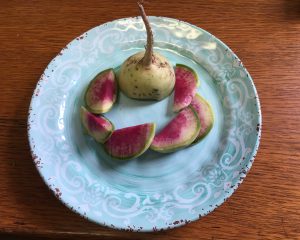
SEASONS/AVAILABILITY
Watermelon radishes are as easy to grow as other radish varieties and can be ordered through online seed catalogs. However, they may take longer to mature than other types of radishes (about 65 days). They are available all year long, with peak growing seasons in the spring and late fall. High temperatures and warm soil can have an effect on the radish’s flavor, making the fruit taste bitter.
NUTRITIONAL VALUE
The fruit, root, and leaves of the watermelon radish provide an excellent source of fiber, vitamin C, and other nutrients, particularly when eaten raw.
SELECTING AND SERVING
When shopping for watermelon radishes, select those that are firm, without bruises or cracks. Watermelon radishes can be served fresh or cooked, hot or cold. Cooking the watermelon radish will enhance its natural sweetness. This fruit’s vibrant color is perfect for topping salads and sandwiches. Watermelon radishes are delicious when pickled.
PICKLED WATERMELON RADISHES
- 1 to 2 watermelon radishes
- ½ cup distilled white vinegar
- ½ cup water
- 1 teaspoon sugar
- 1 teaspoon salt
- ½ teaspoon peppercorns, lightly crushed
- 2 cloves garlic, peeled
- Thoroughly wash radishes, slice into ½ inch-thick discs, and place into clean canning jar.
- In a medium saucepan, bring vinegar, water, sugar, salt, peppercorns, and garlic to boil. Simmer one minute. Pour hot liquid over radishes in canning jar.
- Let cool to room temperature, top with canning lid, and store in the refrigerator.
Yield: 1 cup
The watermelon radish is a low maintenance, easy to grow plant. Only a basic level of care is required to ensure that it thrives. Taking care of its basic growing needs (soil, sun, and water) will result in a strong plant that will make a vibrant and healthy addition to your summer recipes.
by Heidi Copeland | Sep 27, 2016
Autumn, which technically started on the 22nd day of September is a good time to FALL back into good nutrition!
Many Florida crops are in season now. According to the Florida Department of Agriculture and Consumer Services (FDACS); avocados, bell peppers, carambolas, cucumbers, grapefruits, guavas, mushrooms, oranges, peanuts, squash, sweet corn, tangerines and tomatoes are Fresh From Florida® this month. Additionally, our local Red Hills Small Farm Alliance’s seasonal produce includes elephant garlic, lemon grass, shiitake mushrooms and ginger root.
As the temperatures begin to drop, the days continue to get shorter, and the produce of autumn starts to appear, take time to incorporate that produce into your daily diets. Try celebrating October with a delicious, quick to prepare Roasted Vegetable Pasta recipe. Alice Henneman, Extension Educator Southeast Research & Extension Center University of Nebraska Lincoln writes a wonderful blog including recipes and tips with the goal of making you hungry for healthy food! You’ll enjoy this recipe so much you will want to make it again and again with whatever is in season!
Roasted Vegetable Pasta
Servings: 4 side dish or 2 large main dish servings
Exact amounts aren’t needed in this recipe. Just keep the vegetables being roasted at one time to an amount that can be spread in a single, even layer on a pan in the oven.
Ingredients
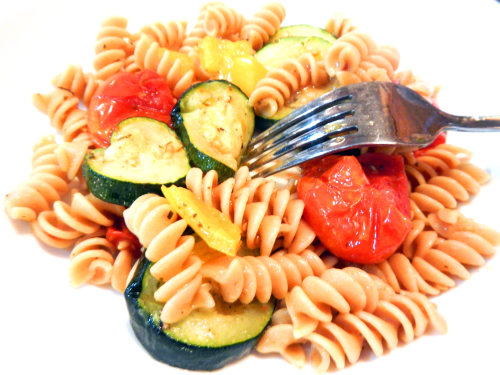 2 to 4 cups cherry tomatoes, left whole with skins
2 to 4 cups cherry tomatoes, left whole with skins- One large bell pepper (any color), cut into 1-inch pieces
- 1 to 2 medium zucchini, cut into 1/4-inch slices
- 3 tablespoons extra virgin olive oil
- 1 teaspoon Italian seasoning
- 8 ounces uncooked pasta (preferably whole grain), such as rotini, farfalle (bow tie shaped) or medium-sized shell pasta
- Salt and pepper (preferably fresh ground pepper) to taste
- Grated Parmesan cheese, preferably freshly grated (optional)
Directions
- Preheat oven to 375 degrees F.
- Mix together cherry tomatoes, bell pepper slices, zucchini and extra virgin olive oil in a large roasting pan, a 9 x 13-inch baking pan or a baking sheet with sides. Spread the vegetables in a single, even layer on the pan. Use a larger pan or a couple of pans if necessary to prevent stacking the vegetables.
- Sprinkle the Italian seasoning over the vegetables.
- Roast for 25 to 35 minutes, until the tomatoes and zucchini are softened and the pepper has started to brown.
- Meanwhile, cook the pasta according package directions. Drain, reserving about 1/2 cup of the pasta water.
- Combine the roasted vegetables with the pasta in a large mixing bowl. Season to taste with salt and pepper. If needed, add reserved cooking liquid by the tablespoonful until you have added enough liquid if pasta requires additional moistening.
- Transfer to a serving dish. Serve and pass the grated Parmesan if desired.
Alice’s Tips
- If you decide to use the recipe for 2 main-dish servings, include the cheese to add some protein to the meal. Or, you might quickly heat some pre-cooked shrimp according to package directions and add to the pasta dish.
Used with permission from: Alice Henneman, MS, RDN, University of Nebraska–Lincoln Extension Educator. For more recipes and tips for fast, healthy and delicious foods, visit https://cookitquick.org/
by Heidi Copeland | Aug 28, 2016
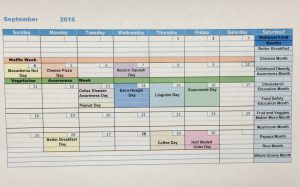
The University of Nebraska – Lincoln (UNL) provides a monthly Calendar of Food Days, Weeks, and Months plus provides resources for selected national food-themes. http://food.unl.edu/september-food-calendar
The month of September boasts a variety of activities using produce that can be grown somewhere in Florida. In fact, many crops are grown locally and are in season now. According to the Florida Department of Agriculture and Consumer Services (FDACS), avocados, carambolas, grapefruits, guavas, mushrooms, oranges, peanuts, and tangerines are Fresh From Florida® this month. http://www.freshfromflorida.com/content/download/16800/269959/09September.pdf In addition, local Red Hills Small Farm Alliance’s seasonal produce includes arugula, Asian greens, eggplant, garlic, okra, southern peas, peppers, radishes, summer and winter squash, figs, Muscadine grapes, pears, and persimmons.
It is easy to incorporate more fruits and vegetables into our diets. Try celebrating September with Vegetarian Awareness Week and consume any of the aforementioned produce, as well as peanuts on National Peanut Day, which is on September 13th.
Peanuts are actually legumes, and can easily fit into many meal plans. Additionally, they are considered a quality protein source for vegetarians. And, according to the Peanut Institute “While ‘nut’ is in their name, peanuts actually grow underground, as opposed to nuts like walnuts, almonds, etc. that grow on trees and are sometimes referred to as tree nuts”.
Peanuts, along with beans and peas, belong to the single plant family, Leguminosae. Leguminosae, commonly referred to as legumes are edible seeds that are enclosed in pods. These plants provide an excellent source of concentrated protein plus, peanuts are rich in vitamins, minerals and phytonutrients, and contain mostly good fats and fiber.
It is fun (and healthy) to experiment with local, fresh Florida produce anytime of the year, and why not have a delicious time this September celebrating a food recognition day, a food awareness week or even an entire month by incorporating Florida fresh foods into your daily, weekly, and monthly meals?
Below is a recipe for a savory peanut sauce, which is very versatile for vegetarian meals and meals with meat or fish. Some ideas for using peanut sauce include:
- Over noodles
- As a dipping sauce for vegetables or spring rolls
- As a baste or condiment for chicken, pork, beef , fish or tofu
- In a stir fry
- In a wrap
- In a slaw
INGREDIENTS
- ¾ cup creamy peanut butter
- ¼ cup rice vinegar
- ¼ cup water
- ⅓ cup reduced sodium tamari or reduced-sodium soy sauce
- 3 tablespoons honey or agave nectar
- 1½ teaspoons grated fresh ginger or ½ teaspoon ground ginger
- 1 to 2 medium cloves garlic, pressed or minced, to taste
- ¼ teaspoon red pepper flakes, plus more for sprinkling
- Optional garnishes: sprinkling of chopped roasted peanuts and additional red pepper flakes
- INSTRUCTIONS
- In a 2-cup liquid measuring cup or medium-sized mixing bowl, whisk together the ingredients until well blended. If your peanut butter is particularly thick, you may need to add a bit more water to thin out the mixture (adding water will mellow out the flavor as well).
- Feel free to adjust to taste here—for example, sometimes I want my sauce more savory and add another clove of garlic, or a little sweeter, so I add extra honey.
- If you’re serving the sauce as a party dip, transfer it to a serving bowl and sprinkle with chopped peanuts and red pepper flakes for some visual interest!
by Heidi Copeland | Jun 12, 2016
What’s in season now? Although summer doesn’t officially start for a few more weeks farmers have been busy producing seasonal, summer fruits and vegetables. The seasonal vegetable guide for North Florida Produce has an abundance! Not only are basil and beans plentiful, so are blackberries, blueberries and mulberries, corn, cucumbers, eggplant, garlic, melons, okra, peas (southern) peppers, summer squash, and tomatoes. (in the southern part of Florida avocado, guava, lychee, mango, papaya, and passion fruit are showing up)
Fruits and vegetables are loaded with great vitamins and minerals! And eating at least 3-5 servings a day of fruits and vegetables is truly considered the key to good health. Folks who eat a wide variety of colors – both fruits and vegetables, as part of an overall healthy diet, are likely to have a reduced risk of some chronic diseases. Both fruits and vegetables provide nutrients vital for health and maintenance of your body.
Eating fruits and vegetables is easy to do!
Have you ever tried using the United States Department of Agriculture What’s Cooking? USDA Mixing Bowl recipe finder? Using this website, I simply checked the box that I’d like to focus on, eating more fruit and vegetables then added the ingredient zucchini to the recipe search box. http://whatscooking.fns.usda.gov/ 
Sixty recipes popped up! I choose the one for Squash Squares.
Squash Squares: Ingredients
4 eggs (beaten lightly)
1/4 cup oil
3 cups thinly sliced squash (use zucchini or yellow squash)
1/4 cup chopped onion
1 cup biscuit mix
1 teaspoon dried parsley (or 2 T chopped fresh parsley)
1/3 cup grated cheddar cheese
1 cup grated carrots
Directions
- Mix all ingredients thoroughly and pour into a greased 9×13″ baking dish.
2. Bake 25 minutes, or until bubbly and brown, in a 350°F oven.
3. Serve in squares while warm.
Notes
- To freeze – Cool, and cut into squares. Freeze squares on a cookie sheet. When they are frozen, put into freezer bags. When ready to use, take out of the freezer bag, place in microwaveable covered container. Reheat in microwave at medium setting.
- Try 8 egg whites in place of whole egg for less cholesterol and fat.
- Add other thinly chopped fresh veggies into the mix – green or red sweet peppers, spinach, broccoli.
I’ve tried this recipe using both yellow squash and zucchini with equally tasty results. I especially appreciated the suggestions on the recipe to personalize by adding your own twist. Like it spicy? Add a jalapeno! Want to add some pizzazz? Add some diced red pepper for color. Want to eat it later? Just freeze and eat or reheat and eat! Don’t have zucchini on hand? Substitute other thinly chopped fresh veggies. I have even substituted the biscuit mix with a corn bread mix for yet another spin.
Fruits and vegetables are nutritious and delicious. Try adding some Florida fresh, seasonal fruits and vegetables to your meals!
 North Florida’s beautiful spring weather means we get to enjoy a variety of delicious, locally-grown fruits and veggies during the summer months. Produce such as bell peppers, squash, tomatoes, greens, corn, cucumbers, okra, peas, eggplant, and a variety of melons are plentiful and fresh from late spring through early fall.
North Florida’s beautiful spring weather means we get to enjoy a variety of delicious, locally-grown fruits and veggies during the summer months. Produce such as bell peppers, squash, tomatoes, greens, corn, cucumbers, okra, peas, eggplant, and a variety of melons are plentiful and fresh from late spring through early fall.




